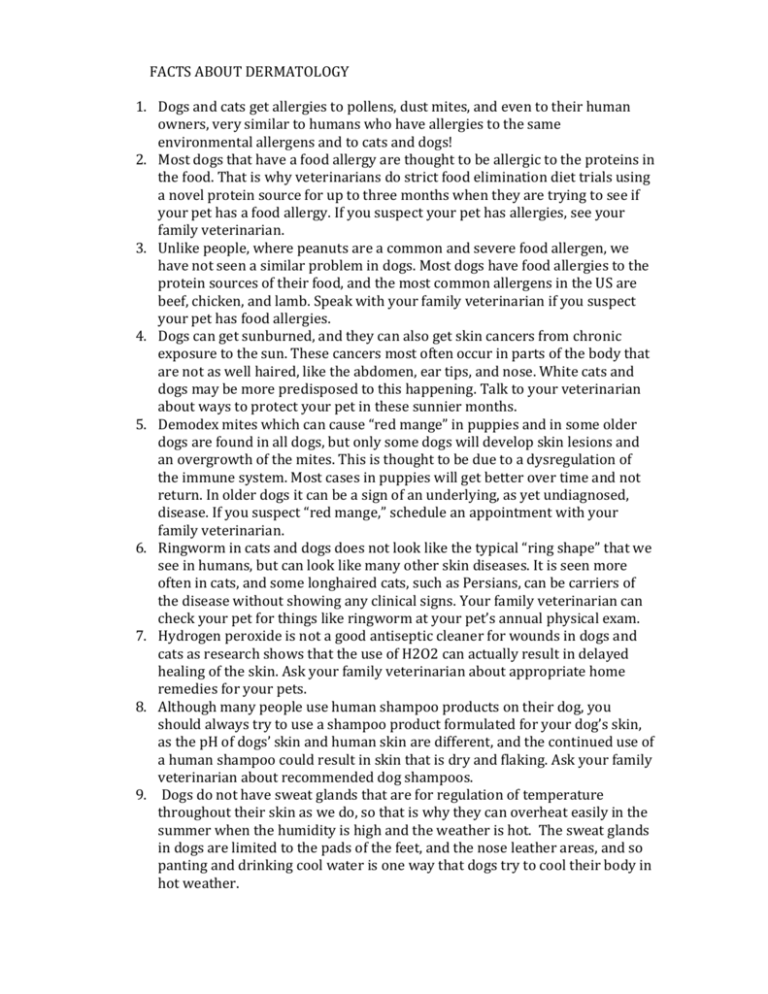FACTS ABOUT DERMATOLOGY Dogs and cats get allergies to
advertisement

FACTS ABOUT DERMATOLOGY 1. Dogs and cats get allergies to pollens, dust mites, and even to their human owners, very similar to humans who have allergies to the same environmental allergens and to cats and dogs! 2. Most dogs that have a food allergy are thought to be allergic to the proteins in the food. That is why veterinarians do strict food elimination diet trials using a novel protein source for up to three months when they are trying to see if your pet has a food allergy. If you suspect your pet has allergies, see your family veterinarian. 3. Unlike people, where peanuts are a common and severe food allergen, we have not seen a similar problem in dogs. Most dogs have food allergies to the protein sources of their food, and the most common allergens in the US are beef, chicken, and lamb. Speak with your family veterinarian if you suspect your pet has food allergies. 4. Dogs can get sunburned, and they can also get skin cancers from chronic exposure to the sun. These cancers most often occur in parts of the body that are not as well haired, like the abdomen, ear tips, and nose. White cats and dogs may be more predisposed to this happening. Talk to your veterinarian about ways to protect your pet in these sunnier months. 5. Demodex mites which can cause “red mange” in puppies and in some older dogs are found in all dogs, but only some dogs will develop skin lesions and an overgrowth of the mites. This is thought to be due to a dysregulation of the immune system. Most cases in puppies will get better over time and not return. In older dogs it can be a sign of an underlying, as yet undiagnosed, disease. If you suspect “red mange,” schedule an appointment with your family veterinarian. 6. Ringworm in cats and dogs does not look like the typical “ring shape” that we see in humans, but can look like many other skin diseases. It is seen more often in cats, and some longhaired cats, such as Persians, can be carriers of the disease without showing any clinical signs. Your family veterinarian can check your pet for things like ringworm at your pet’s annual physical exam. 7. Hydrogen peroxide is not a good antiseptic cleaner for wounds in dogs and cats as research shows that the use of H2O2 can actually result in delayed healing of the skin. Ask your family veterinarian about appropriate home remedies for your pets. 8. Although many people use human shampoo products on their dog, you should always try to use a shampoo product formulated for your dog’s skin, as the pH of dogs’ skin and human skin are different, and the continued use of a human shampoo could result in skin that is dry and flaking. Ask your family veterinarian about recommended dog shampoos. 9. Dogs do not have sweat glands that are for regulation of temperature throughout their skin as we do, so that is why they can overheat easily in the summer when the humidity is high and the weather is hot. The sweat glands in dogs are limited to the pads of the feet, and the nose leather areas, and so panting and drinking cool water is one way that dogs try to cool their body in hot weather.




